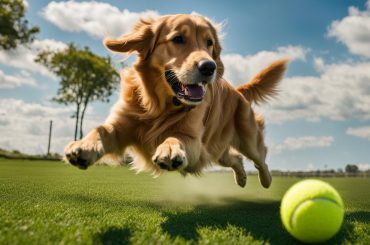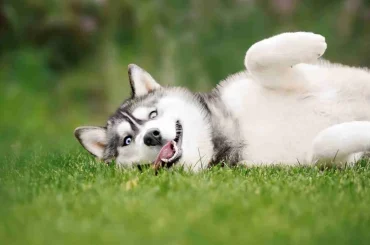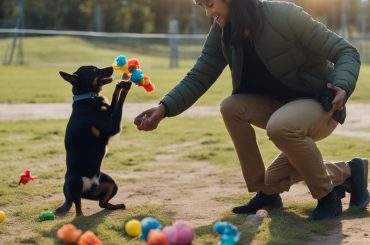Are you interested in shed hunting with your dog? Shed hunting is a popular outdoor activity that allows dogs to use their natural instincts to find antlers that have been shed by deer and other animals. Teaching your dog to find sheds requires training and consistency, but with the right approach, it can be a fun and rewarding experience for both you and your furry companion.
In this article, I will share shed dog training tips and techniques to help you teach your dog the skills they need to become a successful shed hunter. From introducing them to the shape of an antler to conditioning their sense of smell to connect with shed antler scents, we will cover all the essential steps to get started.
Key Takeaways:
- Shed dog training involves forming habits through repetition and consistency.
- Introduce your dog to the shape of an antler to tap into their natural retrieving instincts.
- Condition your dog to recognize the scent of a shed antler and connect it to the reward of a retrieve.
- Don’t worry too much about human scent on the antler; focus on training and reinforcement instead.
- Maintain a positive attitude and train with short, frequent sessions to ensure success in shed hunting.
Keep it Simple: The Basics of Shed Dog Training
Shed dog training doesn’t have to be complicated. The key is to keep it simple and integrate training into your daily routine. Dogs are always learning, so consistency is crucial. By focusing on reinforcing positive habits and avoiding bad ones, you can effectively train your dog to become a skilled shed hunter. To put it simply, shedding hunting is all about forming habits, and these habits are built through repetition and consistency.
To start, incorporate short training sessions into your daily routine. These sessions should last no longer than 15 minutes, three times per week. This approach prevents frustration and ensures that your dog has plenty of time to learn shed-antler skills. By keeping the training sessions frequent and short, you will be able to reinforce positive behaviors and see progress in your dog’s shed hunting abilities.
Consistency is key when it comes to shed dog training. Focus on reinforcing positive behaviors and avoiding bad habits. Use consistent commands and reward your dog for successful retrievals. By maintaining a positive attitude and training with excitement, you will create a positive learning environment for your dog. To put it simply, your attitude and approach will reflect in your dog’s efforts.

Frequently Asked Questions
- How often should I train my dog for shed hunting?
It is recommended to train your dog for shed hunting three times per week, with each session lasting no more than 15 minutes. Short, frequent training sessions are more effective than long, infrequent sessions. - What if my dog doesn’t seem interested in retrieving?
If your dog shows little interest in retrieving, try using interactive toys or treats to stimulate their curiosity. Gradually introduce the shape of an antler and connect it with a rewarding retrieve to build their interest and enthusiasm. - Can any dog be trained for shed hunting?
While certain breeds may have a higher natural instinct for retrieving, almost any dog can be trained for shed hunting with patience and consistency. I recommend that you work with your dog’s individual abilities and strengths.
By keeping shed dog training simple, consistent, and enjoyable, you can successfully teach your dog the skills needed for shed hunting. Try to focus on reinforcement, incorporate training into your daily routine, and maintain a positive attitude throughout the process. With time and dedication, your dog can become a proficient shed hunter, enhancing your outdoor experiences and adventures.
| Training Tip | Explanation |
|---|---|
| Consistency is key | Reinforce positive behaviors and avoid bad habits by consistently using commands and rewards during training sessions. |
| Short, frequent sessions | Train your dog for shed hunting in short, frequent sessions to prevent frustration and maintain their focus and enthusiasm. |
| Patience and positivity | Be patient with your dog’s progress and maintain a positive attitude throughout the training process. This positive energy will reflect in your dog’s efforts. |
Condition the Shape: Introducing Your Dog to the Antler
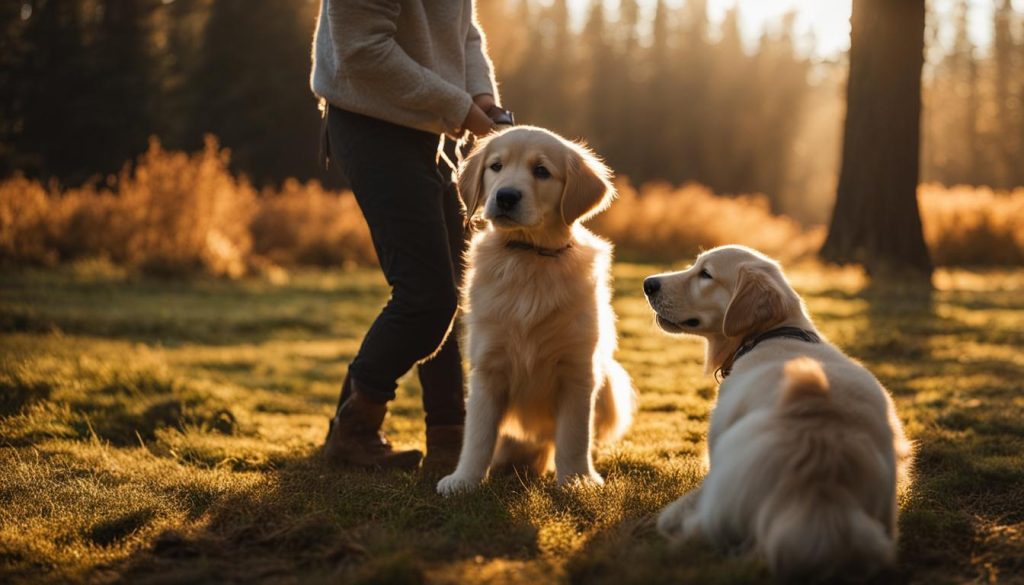
Before diving into scent training, introduce your dog to the shape of an antler. Start by using a soft replica to tap into their natural instincts for retrieving. Conditioning the shape of the antler will help your dog understand what object they are searching for during shed hunting. This is an important step in the training process that sets the foundation for further training and reinforcement.
By gradually introducing the soft replica, you can help your dog become familiar with the shape, size, and texture of an antler. Begin by allowing your dog to sniff and interact with the replica, encouraging them to pick it up and carry it. Use positive reinforcement such as treats and praise to reward your dog for engaging with the antler.
As your dog becomes more comfortable with the soft replica, gradually increase the difficulty by hiding it in different locations and encouraging your dog to find it. This will help develop their problem-solving skills and strengthen their ability to locate objects in various environments. Try to provide plenty of encouragement and rewards throughout the training process to keep your dog motivated and engaged.
Conditioning the Shape: Introducing Your Dog to the Antler
| Training Steps | Description |
|---|---|
| Step 1 | Introduce the soft replica of an antler to your dog. |
| Step 2 | Encourage your dog to sniff, pick up, and carry the replica. |
| Step 3 | Increase the difficulty by hiding the replica in different locations for your dog to find. |
| Step 4 | Provide positive reinforcement, such as treats and praise, to reward your dog’s engagement and success. |
The Power of Scent: Connecting Dogs to Shed Antlers
When it comes to shed hunting, dogs rely heavily on their sense of smell. Training your dog to recognize the specific scent of a shed antler is crucial for successful searches. Shed antlers have a distinctive odor that contains various scent clues, including bone smells, hair and blood, forehead gland scent, rubbed debris, and scents left by coyotes and rodents. Understanding how dogs process these scents and training them to connect the scent of a shed antler to the reward of a retrieve is essential.
Dogs have a highly developed sense of smell, and they process scents differently from humans. To train your dog to recognize the scent of a shed antler, start by incorporating scent-based activities into their training routine. Use a shed antler that has been rubbed with a cloth containing the scent of a shed antler or a commercially available shed antler scent product. Introduce the scent to your dog and associate it with a reward, such as a treat or a retrieve. Repeat this process consistently to reinforce the connection between the scent and the reward.
“By training your dog to recognize the scent of a shed antler, you are tapping into their natural abilities and enhancing their shed hunting skills.”
During training, use appropriate commands to guide your dog’s search for shed antlers. Common commands used in shed dog training include “find it,” “fetch,” and “hold.” Consistency in command usage and reinforcement of positive behavior are key to helping your dog understand what they are searching for during shed hunting. With proper training, your dog will learn to associate the scent of a shed antler with the command and the reward of a retrieve, making them an efficient shed hunting companion.
The Power of Scent: Connecting Dogs to Shed Antlers
| Scent Clues on Shed Antlers | Description |
|---|---|
| Bone Smells | The natural scent of the bone material on the shed antler. |
| Hair and Blood | The scent left behind from hairs and traces of blood on the shed antler. |
| Forehead Gland Scent | The scent released from the forehead gland of deer, which is deposited on the shed antler during rubbing. |
| Rubbed Debris | The scent from other materials, such as leaves or vegetation, that the shed antler has come into contact with during rubbing. |
| Coyote and Rodent Scents | The scents left by predators and scavengers that interact with the shed antlers in the wild. |
Training your dog to recognize the scent of shed antlers is a skill that takes time and consistency. By tapping into your dog’s natural abilities and enhancing their shed hunting skills through scent training, you can ensure successful and rewarding shed hunting experiences.

Dealing with Human Scent and Contamination Concerns
When it comes to shed dog training, many handlers are concerned about the presence of human scent on the antler and its potential impact on their dog’s ability to find sheds. While it’s natural to want to eliminate all traces of human scent, complete scent elimination is neither realistic nor necessary. Instead of becoming overly focused on scent elimination, handlers should prioritize training and reinforcement to maximize their dog’s success in shed hunting.
Washing antlers and wearing rubber gloves can help minimize human scent, but these measures also remove desirable scents that dogs need to recognize during shed hunting. Dogs rely heavily on their sense of smell to locate sheds, and by prioritizing training sessions and consistent reinforcement, handlers can help their dogs build the necessary skills to overcome any potential contamination concerns.
“Complete scent elimination is not necessary in shed dog training. By focusing on training and reinforcement, handlers can help their dogs succeed in shed hunting.”
I recommend that you remember that dogs are more focused on the retrieve itself rather than the specific object being retrieved. While minimizing human scent is beneficial, it’s not the determining factor in a dog’s ability to find sheds. By dedicating time and effort to training sessions and reinforcement, handlers can set their dogs up for success in shed hunting, regardless of any residual human scent on the antler.
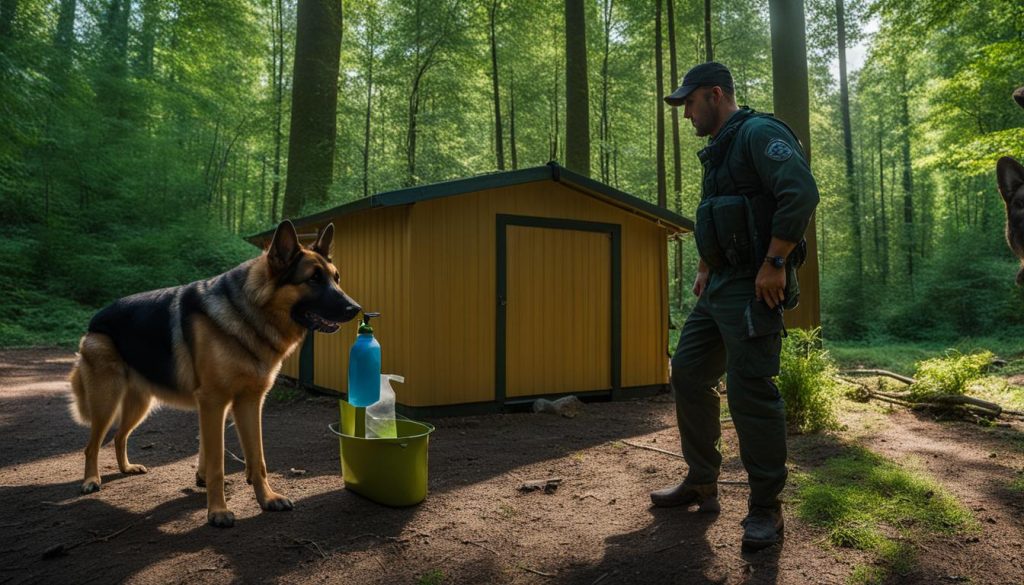
| Dog Scent Training Tips |
|---|
| Focus on training and reinforcement |
| Minimize but don’t obsess over human scent |
| Train frequently and consistently |
| Emphasize the retrieve rather than scent elimination |
Frequency and Attitude: Training Strategies for Success
When it comes to training your dog to find sheds, frequency and attitude are key factors for success. Training sessions should be short and frequent, lasting no more than 15 minutes per day, three times per week. This approach prevents frustration and gives your dog plenty of time to learn the skills needed for shed hunting.
I recommend that you maintain a positive attitude throughout the training process. Understand that your dog won’t learn overnight and that training takes time and consistency. Enjoy the training process, and train with excitement and reward proper behavior. Your attitude and approach will reflect in your dog’s efforts.
Creating a training schedule and sticking to it helps to establish a routine for both you and your dog. Consistency is key to reinforce positive habits and avoid bad ones. By training regularly and maintaining a positive attitude, you’ll set yourself and your dog up for success in shed dog training.
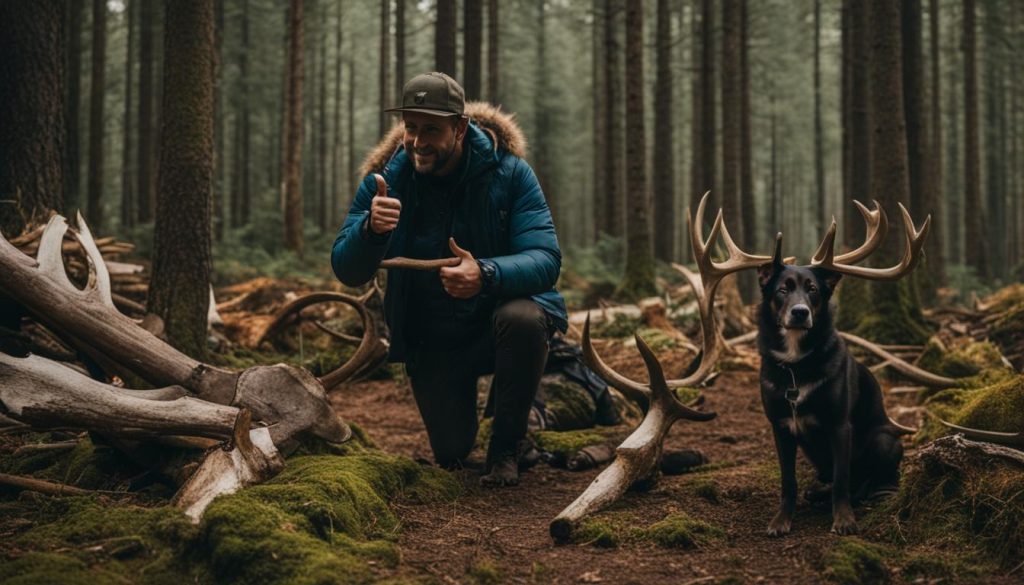
Training Tips:
- Keep training sessions short and frequent, with no more than 15 minutes per day, three times per week.
- Maintain a positive attitude and train with excitement to motivate your dog.
- Establish a routine by creating a training schedule and sticking to it.
- Focus on reinforcing positive habits and avoiding bad ones through consistent training.
By following these training strategies, you’ll increase the likelihood of success in training your dog to find sheds. Try to be patient and enjoy the process, as building a strong foundation through frequency and a positive attitude will lead to rewarding shed hunting experiences with your furry companion.
The Retrieve: Building the Foundation for Shed Hunting
When it comes to shed hunting, the retrieve is a key skill that your dog needs to master. By teaching your dog to retrieve objects such as balls or toys, you can lay the foundation for their shed hunting abilities. Incorporate regular fetch games into your training sessions to reinforce the behavior and reward your dog for bringing back what they retrieve.
The retrieve is essential in shed hunting because it serves as the ultimate reward for dogs. By mastering the retrieve, your dog learns to associate finding a shed with the excitement and satisfaction of retrieving an object. This connection strengthens their drive and motivation to search for sheds during your outdoor adventures.

Try to be patient and consistent in your training. Start with short, frequent sessions that last no more than 15 minutes per day, three times per week. Maintaining a positive attitude throughout the training process will make it more enjoyable for both you and your dog. Train with excitement and reward proper behavior, and soon your dog will be well on their way to becoming a successful shed hunter.
Shape Identification and Progression in Shed Hunting Training
In shed hunting training, once your dog has mastered the retrieve skill, it’s time to gradually introduce them to the shape of a shed antler. This step is important in shaping their ability to recognize and differentiate the object they are searching for during shed hunting. Begin by using a soft replica of an antler to eliminate the risk of injury from a real antler. This allows your dog to become familiar with the shape and size of an antler, preparing them for the next phase of training.
During this stage, you can engage your dog in fetch games using the soft antler in a narrow hallway. This confined space helps them focus on the specific object they need to retrieve. As they become more comfortable, you can gradually progress to more challenging locations, such as hiding the soft antler in different areas of your home or yard. This progression helps your dog generalize their retrieval skills and prepares them for real shed hunting scenarios in various environments.
Consistency is key during shape identification and progression training. Use consistent commands to help your dog understand what they are searching for and reward them for successful retrievals. Positive reinforcement plays a crucial role in reinforcing their skills and building a strong foundation for shed hunting. With time and practice, your dog will become proficient in identifying the shape of a shed antler and will be better equipped to find sheds during your outdoor adventures.

| Training Steps | Action |
|---|---|
| Step 1 | Introduce soft replica of a shed antler |
| Step 2 | Engage in fetch games in a narrow hallway |
| Step 3 | Gradually hide the soft antler in more challenging locations |
| Step 4 | Use consistent commands and reward successful retrievals |
Benefits of Shape Identification and Progression Training
- Helps dogs recognize the specific shape of a shed antler
- Prevents confusion with other objects during shed hunting
- Builds strong retrieval skills and reinforces positive behaviors
- Prepares dogs for shed hunting in various environments and scenarios
Final Thoughts
Training your dog to find sheds is an exciting and rewarding endeavor that can greatly enhance your outdoor experiences. By following the steps outlined in this guide, you can effectively teach your dog the necessary skills for shed hunting.
Try to keep the training process simple and incorporate it into your daily routine. Consistency is key, so reinforce positive habits while avoiding bad ones. By conditioning your dog to recognize the shape of an antler and connecting it to the reward of a retrieve, you can tap into their natural instincts for retrieving and enhance their shed hunting abilities.
While some handlers may be concerned about human scent contamination on the antler, prioritize training and reinforcement over excessive scent elimination. Dogs are more focused on the retrieve itself rather than the specific object being retrieved. Maintain a positive attitude throughout the training process, and enjoy the journey of watching your dog progress and excel in shed hunting.
With time, patience, and consistency, your dog can become an expert shed hunter, bringing excitement and success to your outdoor adventures. So, grab your furry companion and embark on this fulfilling journey together.
FAQ
What is shed dog training?
Shed dog training is the process of teaching dogs to locate shed antlers, which are naturally shed by deer and other animals. It involves forming habits through repetition and consistency to help dogs recognize the shape and scent of an antler and retrieve it as a reward.
How often should I train my dog for shed hunting?
Training sessions should be short and frequent, lasting no more than 15 minutes per day, three times per week. This allows for consistent reinforcement and prevents frustration for both you and your dog.
How do I introduce my dog to the shape of an antler?
Start by using a soft replica of an antler to tap into your dog’s natural instincts for retrieving. Begin with fetch games in a narrow hallway and gradually progress to hiding the soft antler in more challenging locations to teach your dog to recognize the shape of an antler.
What are the scents found on an antler?
Shed antlers have a variety of scent clues, including bone smells, hair and blood, forehead gland scent, rubbed debris, and scents left by coyotes and rodents. I recommend that you understand these scents and how dogs process them in order to train them to recognize the scent of a shed antler.
How do I address concerns about human scent on the antler?
Complete scent elimination is not necessary or realistic. Instead, prioritize training and reinforcement. Dogs are more focused on the retrieve itself rather than the specific object being retrieved. Focus on training sessions and consistent reinforcement over excessive scent elimination measures.
How long will it take for my dog to become a proficient shed hunter?
Shed hunting training takes time and consistency. Every dog learns at their own pace, so maintain a positive attitude throughout the training process. Enjoy the training process and train with excitement and reward proper behavior. With time and consistency, your dog can become an expert shed hunter.



